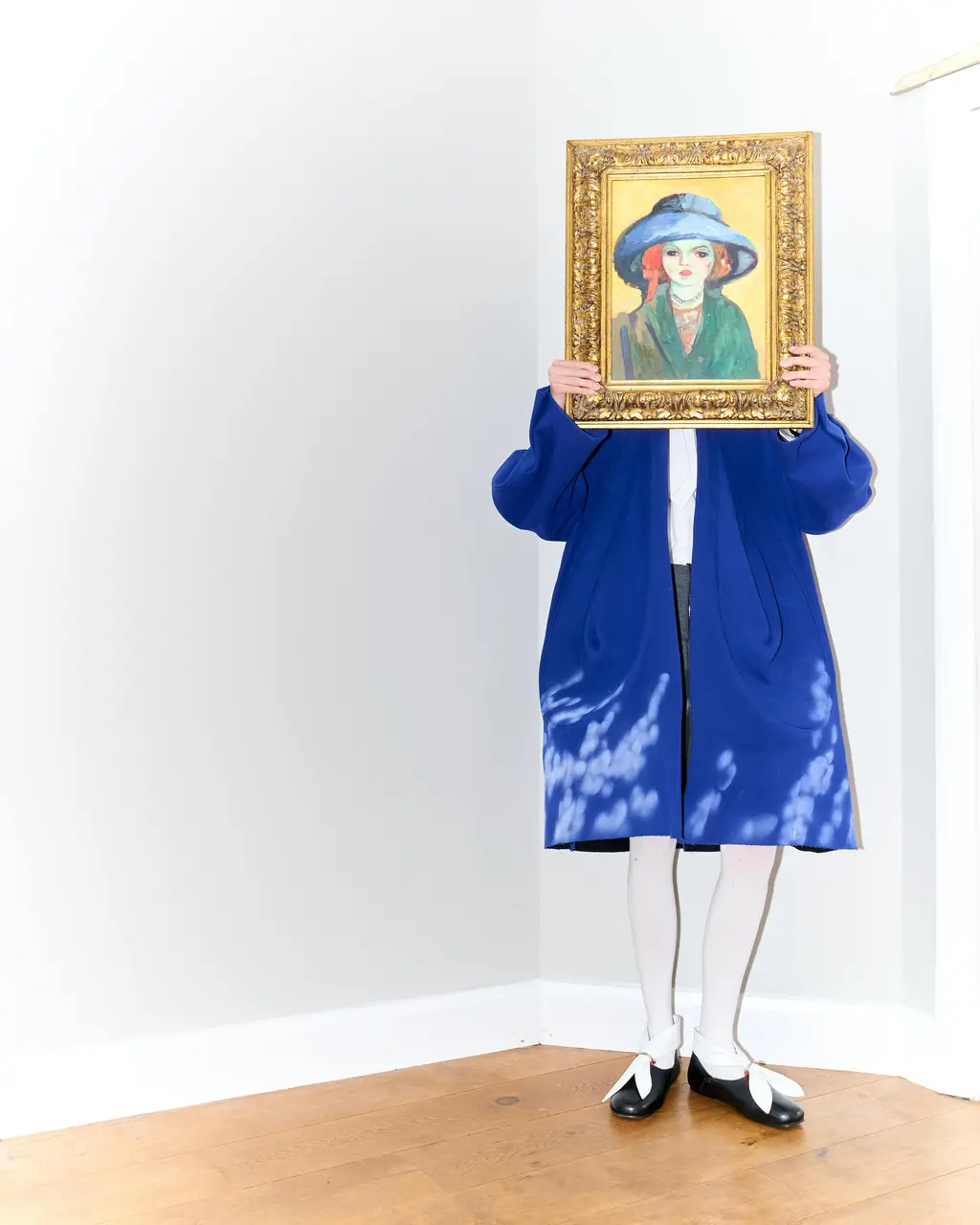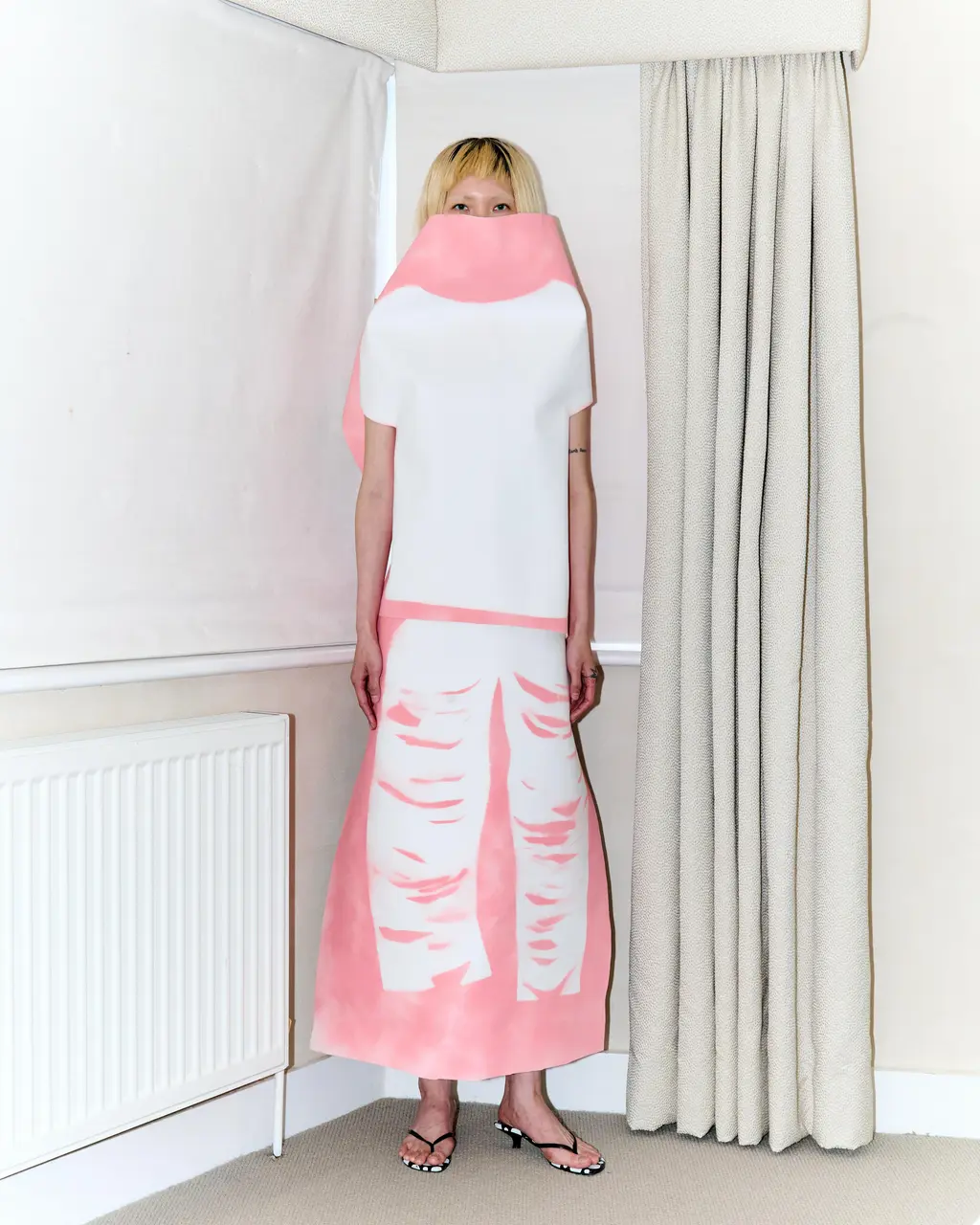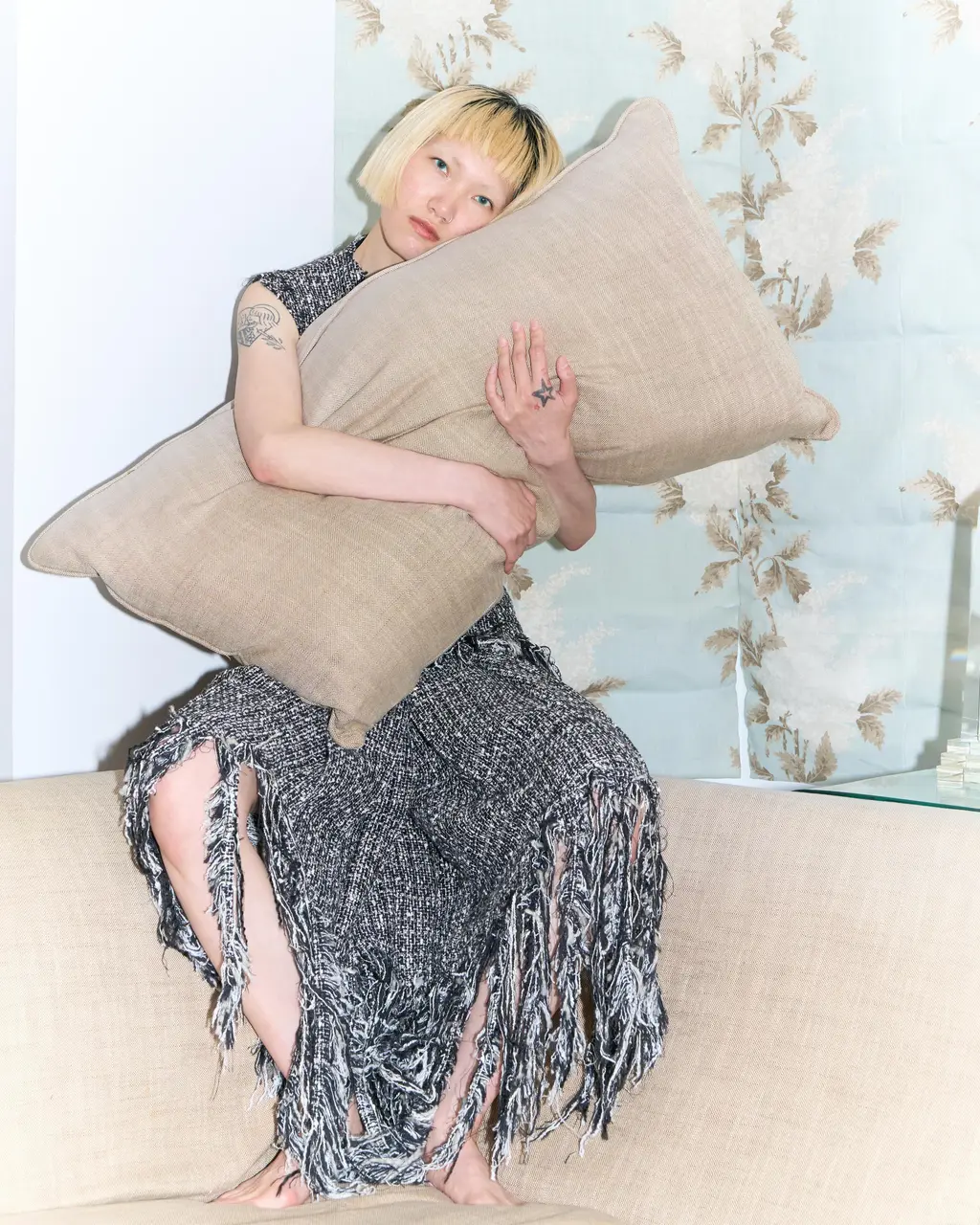Five Central Saint Martins graduates on life after uni

Cap SOLE SCONCIAFORNI, jacket LEWIS PAYNE
Photographer Max Lancaster shot five fresh graduates’ final-year collections at his parents’ gaff. We asked them all about it.
Style
Words: Tiffany Lai,
Eni Subair
Photography: Max Lancaster
Wet weather, big scarves, leaves crunching underfoot: it smells like back to school time. And at Central Saint Martins in London, freshers are just about settling into their first term, with final projects/crits/dissertations a world away.
To commemorate the new term, photographer Max Lancaster (along with recent grad and stylist Cami Ridgers) has hand-picked five new CSM graduates who he believes will be fashion’s next rising stars. To hammer it home, he’s featured their designs in a new editorial.
There’s Hamish Olrik who specialises in cheerful menswear, Lewis Payne and his knack for dramatic pleating, and Sole Sconciaforni, whose speciality involves deconstructing everyday garments into something a little more spontaneous. Gwendoline English, meanwhile, looks to folk-inspired craft, and Ruby Hamilton is fascinated by lineage and the stories we tell.
For the occasion, Max was inspired by the tenants that have been passing through his parents’ North London home since 2022. Often fashion models on placement in the city, “they would hide in their bedroom during their stay and were rarely seen by me or my parents,” he says. “I loved the concept of the camera ‘seeking’ the models – who are in London to be photographed, yet prefer to stay hidden at home.” Originally titled Hide and Seek, the shoot features models awkwardly hiding behind unusual objects around the house, as a way to evoke a sense of discomfort and “feeling out of place”.
As for for wide-eyed students who may feel a little out of place themselves, some advice couldn’t hurt, right? Here, each ingenious designer spills the tea on what they’d relive, what they’d tell their first-year selves, and the realities of the world post-grad.




Hamish Olrik, 23, menswear





What intrigues you about menswear these days?
Trying to find a balance between something that feels true to menswear [but] doesn’t necessarily serve the archetypal characters that still underpin men’s fashion.
What inspires you?
My experience living in Denmark for six months, between Copenhagen and my grandmother’s bungalow, is a recurring point of reference for my work. Her house serves as a time capsule for our family history.
Her collection of film photos is stored throughout the house, whether in between books in the living room, inside drawers or under the bed. They date back to the early 20th century, depicting both her and my mother’s childhood growing up between Denmark, Sweden and Australia with my grandfather and my mother’s two brothers.
Describe your clothes in one sentence.
A process of breaking down archetypal menswear tropes and re-contextualising them through materiality, form and colour.
Who’s your go-to menswear designer?
Giorgio Armani.
Lewis Payne, 23, menswear




Talk us through your design techniques…
I like working with weight, texture and lines – using something light and giving it weight, or something flat and giving it depth. Using different pleating techniques helps me to communicate those ideas.
What do you make of the current fashion climate?
Hodakova winning the 2024 LVMH Prize shows the need for innovation within sustainability. It’s exciting and inspiring, especially for young designers.
Which materials do you usually work with?
Practical fabrics [such as] nylons, various denim and jerseys. Pre-worn garments and anything I can get for free. I work with a lot of sportswear-inspired materials I can manipulate and show in different ways to how they are usually seen.
What advice would you give to a young person wanting to get into fashion?
Trust yourself, learn how to cut and sew, and develop your own perspective.
What’s a moment from studying you’d love to relive?
My final year. Having the opportunity to develop a collection with access to the facilities, studios and peer advice is so important and rare.
Sole Sconciaforni, 23, womenswear





You’ve previously mentioned being inspired by discarded clothes on the floor. What does your bedroom look like?
Messy. I like to be spontaneous, so I end up rushing to get dressed most of the time. However, my favourite outfits have come from situations like this, when I literally don’t have the time to overthink it – resulting in weird pattern combinations, inside-out T‑shirts, scrunched blouses, one leg of a trouser stuck in a boot…
You work with second-hand garments to keep up sustainability and challenge our relationship with clothing. Why is it important to think and work this way?
Using second-hand garments comes from a personal interest in displaying forms, textures and patterns that feel and look familiar. [This allows for] new perceptions of everyday times, places, and actions.
How would you describe your final collection?
An artefact of the complex and emotional relationship I have with my city, Rome.
How did you feel seeing your clothes go down the runway for your final show?
An explosion of emotions and stress release. But my favourite part is always the backstage moment because you see the build up of your creations taking form in an environment of pure chaos around you.
What advice would you give to a fashion student entering their final year?
You need to keep a clear and positive mind. I wouldn’t be too interested in what other people are doing. Only you know what works for you, so trust your instincts and vision and stop comparing yourself to others. Surround yourself with positive energy and friends and ignore all the rest, but also don’t take yourself too seriously. It’s just clothes in the end.
Ruby Hamilton, 23, womenswear





Why did you name your final BA collection je me souviens?
“Je me souviens”. translates to “I remember”. What better way to romanticise our rose-tinted past than through the language of love? The collection revolves around embellished and fabricated stories integral to the personal history of my Scottish grandparents, and centred around a narrative of souvenir collecting that never came to be.
What’s your favourite souvenir?
My mum’s wedding ring. I wasn’t there, but this little piece of metal somehow made me feel like I was. Then, there’s a T‑shirt with Pete Doherty on it that I wore when I was eight, which I now wear as a baby tee.
Your grandparents are a big inspiration to you. What did they think of the collection?
My nan is a bit of a nutter – she walked the show with a broken foot, wearing the receipt dress. She loved it, which is ironic since the whole collection was inspired by her ex-partner, my grandad, who has dementia. I also have a step-nan and she adored it too.
As for my grandad, he has no idea it even happened due to his dementia. I like that he doesn’t know; it keeps an innocence to his stories. His storytelling has taught me not to take fashion too seriously and that you can create beautiful, meaningful pieces rooted in the most unserious things.
It’s also reminded me how fun lying can be, and that maybe we should all do it a bit more often.
What are your plans post-Central Saint Martins?
Live, laugh, love. And make some money.
Gwendoline English, 23, womenswear





Your final collection involved working with twigs and feathers. What was that process like?
The process was both messy and dynamic, a constant back-and-forth between the studios at CSM, my home and Hampstead Heath where I gathered the materials. Weaving the willow structure required a lot of patience, and collecting the twigs and feathers was a great excuse to immerse myself in nature during a stressful time.
The feather dress, in particular, was incredibly labour-intensive but it was intentional – it symbolised how a simple, repetitive act can accumulate into something greater, a reflection of traditional handwork found in many folklore traditions. Each feather was individually attached, a method that embodied the slow, meticulous craft I wanted to honour.
Have you always been an outdoorsy person?
Absolutely. Urban environments can feel stifling to me and I feel like they’re robbing you of inspiration or a sense of connection. I’m also drawn to the unpredictability and challenge of nature. There’s something so visceral about being caught in the woods at night or finding yourself in the middle of a sudden downpour.
Which techniques did you use to honour artisanal craftsmanship?
During my research, I immersed myself in traditional craftsmanship, particularly from folklore groups that lived in the mountains. I was particularly inspired by the Ukrainian film Shadows of Forgotten Ancestors, which beautifully captures the raw, emotional lives of people living off the land in the Carpathian mountains. That sense of living closely with nature, relying on your hands to create what you need, was something I wanted to bring into my work.
What do you hope the audience at the graduate show took away from the collection?
More than anything, I wanted it to feel like a breath of fresh air, something that stood apart from the typical fashion narrative. I wanted people to look at the clothes and feel like they’d stepped into a film or documentary, something evocative and full of stories, rather than just another runway show.
If you could give your younger self some advice now, what would it be?
I would tell myself to have more fun with it all and not to rush the process. There’s no need to compare your pace with others. Everyone’s journey is different. What matters most is focusing on yourself and your learning. Absorb as much knowledge as you can and don’t be afraid to take your time.





























